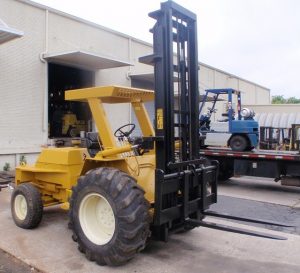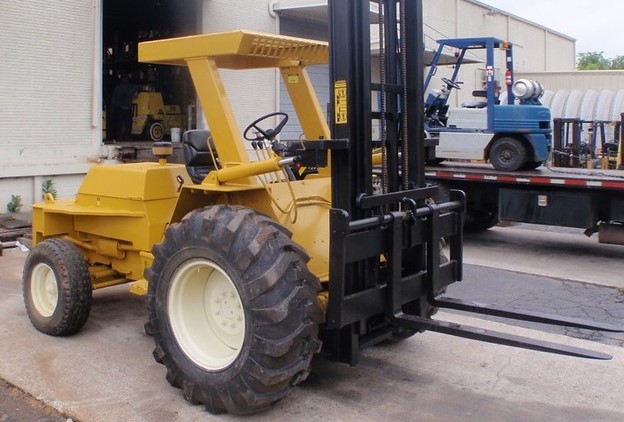Rough Terrain Forklifts
A rough terrain forklift is specifically designed to carry material over an unstable, rocky, or tough to navigate surface. It is true that it has many of the same characteristics as a standard forklift; it is constructed for outdoor use, not in a warehouse or factory.
These forklifts feature heavier duty construction and rugged tires designed to operate over rough terrain. They are typically used in construction or to lift materials onto a roof or upper floor of a building under construction. In addition, they are used to unload supplies from a truck and then transport the goods to an oil rig or road construction site. The military also relies on this type of forklift to carry items on military bases or camps. They are also used on ranches and farms.
Rough terrain forklifts are designed in two basic configurations. Each is meant to lift different types of loads and lifting operations. The vertical mast configuration is the most common. It is similar to an indoor forklift and features vertical support in the area in front of the driver and tines that extend away from the front of the lift parallel to the ground. A rough terrain forklift with variable reach has greater flexibility than a vertical mast configuration and includes a telescoping boom. this boom allows the operator to lift items over obstacles or obstructions.

A rough terrain forklift.
(courtesy: rrforklift at flickr.com)
They are designed and constructed to withstand outdoor elements including rain, wind and corrosive materials. They are commonly made of galvanized steel or composite materials to resist moisture. They also feature a stronger frame so they can lift heavier loads higher than a conventional forklift.
The rough terrain has tires with maximum traction and stability so the lift can cross over uneven, rough terrain. The tires are large and knotted to better grip the soil and traverse over obstacles. The tires are also reinforced to protect them from puncturing or from damage from rocks or other materials. The larger tires also prevent the lift from sinking into loose or soft ground and assist in passing over sloped or unstable areas safely. Many lifts include front or four wheel drive for improved maneuverability and better handling in any type of terrain.
Although these machines have been designed and constructed in rough conditions, a great deal of caution is necessary when operating one. Without proper knowledge in driving these lifts an operator could cause it to tip over.
As with any forklift, raising a load should be performed when it is on a stable surface. Having knowledge in handling a load and knowing the stability of the ground conditions is crucial for safe operation.
Safety Guidelines
The Occupational Safety And Health Administration (OSHA) is the government agency that has jurisdiction over the safe operation of rough terrain forklifts. Although the agency does not set a specific speed limit for these machines, it suggests that drivers should maintain a safe speed at all times.
Factors that go into determining a safe speed include surface condition, load stability, personnel in the area, other machinery operating in the vicinity.
An operator of a rough terrain forklift is expected to wear a seatbelt, a hard hat, safety glasses and ear plugs.
An internal combustion engine commonly powers a rough terrain forklift. So it may need refueling often. Operators must be aware of hazards associated with the fuel, which is commonly gasoline, diesel, or propane. A fire extinguisher must be on hand when refueling a rough terrain lift.
(Sources: oshasafetymanagement.com and wisegeek.com)

